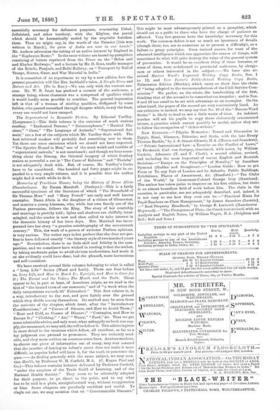We have received several little volumes belonging to what is
called a "Long Life" Series (Ward and Lock). There are four before us, Long Life, and How to Reach It; Eyesight, and How to Care for It; The Throat and the Voice ; The Mouth and the Teeth. These appear to be, in part at least, of American origin, as we read in the first of " the heated term of our summers," and of " a week when the daily temperature exceeds 95° Fahrenheit." This first volume is, in a way, introductory to the rest, and goes lightly over the ground which they divide among themselves. Its method may be seen from the contents of the chapter, which treat, after the " Introductory Considerations," of " Causes of Disease, and How to Avoid Them ;" " Heat and Cold, as Causes of Disease ;" " Contagion, and How to Escape It ;" " Clothing," Air," " Water," " Food," &c. Thus we get some admirableadvice, and only want, what unhappily no book can sup- ply, the means and, we may add, the will to follow it. This advice is gi ven in more detail in the treatises which follow, all excellent, as far as a lay judgment can pretend to pronounce. They are certainly read- able, and they seem written on common-sense lines. Anxious mothers, to choose one piece of information out of many, may rest assured that the practice of lancing an infant's gums does not make it more difficult, as popular belief will have it for the tooth to penetrate the gam.—As dealing generally with the eame subject, we may men tion Health, by Professor W. H. Corfield, M.A. (C. Regan Paul and Co.)—This volume contains lectures delivered by Professor Corfield, "under the auspices of the Trade Guild of Learning, and of the National Health Society." They seem to be admirably adapted for their purpose, to go direct to the point, and to say what has to be said in a plain, straightforward way, without exaggeration or bias. Some chapters are peculiarly excellent and useful. To single out ono, we may mention that on " Communicable Diseases." This might be most advantageously printed as a pamphlet, which should act as a guide to those who have the charge of patients so affected. Very few persons have the knowledge necessary for this work. The common defect is not so much an ignorance of details (though these, too, are so numerous as to present a difficulty), as a failure to grasp principles. Even trained nurses, for want of the educated intelligence which can appreciate the reason of things, will sometimes do what will quite destroy the value of the general system of precaution. It would be an excellent thing if these lectures, or some of them, were redelivered to provincial audiences, by clergy- men or others interested in the subject.—We have also re- ceived Marcus Ward's Improved Writing Copy Books, Nos. 1 to 12, and Pere Foster's Public-School Writing Copy Books, Palmerston Edition (Blackio), which carry on their face the claim of "being adapted to the recommendations of the Civil Service Com- mission." We prefer, on the whole, the handwriting of the first, thinking that of the second to be somewhat too irregular ; and in Nos. 9 and 10 too small to be set with advantage as an exemplar. On the other hand, the pages of the second are very conveniently lined. As our criticism is invited, we may say that No. 10 of the " Marcus Ward Series" is likely to lead to not a little waste of time. An indolent teacher will set his pupils to copy these elaborately ornamented letters, a practice which cannot possibly be useful, unless they are to follow the occupation of " ticket-writers."


































 Previous page
Previous page